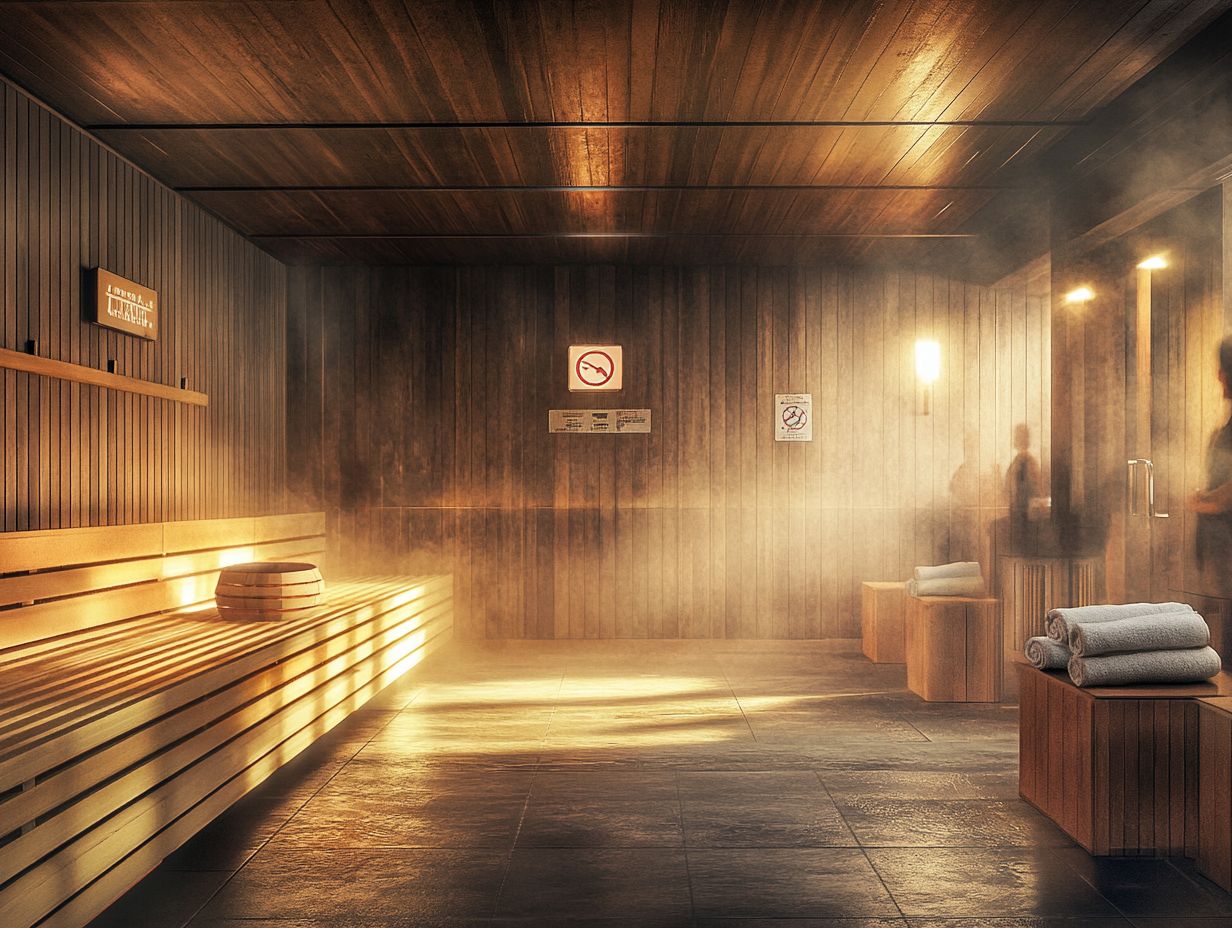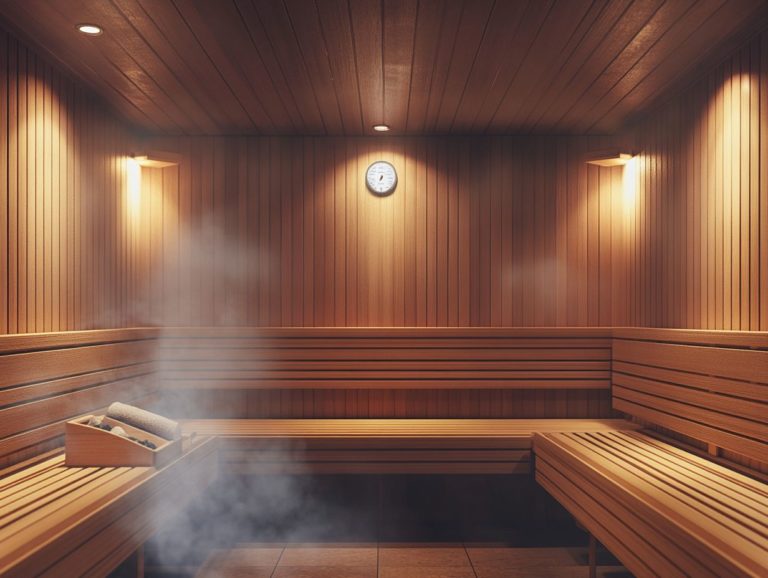Sauna Safety: Understanding Different Perspectives
Saunas have long been revered for their relaxing and rejuvenating effects. But how much do you truly know about their history, benefits, and potential risks?
This article explores the captivating evolution of sauna use and the numerous physical and mental health benefits it provides. It’s important to consider precautions; you ll find an examination of potential risks, along with expert insights on safety.
Whether you re a seasoned sauna enthusiast or simply curious, this guide offers essential insights and best practices for ensuring a safe and enjoyable sauna experience.
Contents
- Key Takeaways:
- Overview of Sauna Use
- Benefits of Sauna Use
- Potential Risks of Sauna Use
- Different Perspectives on Sauna Safety
- Ensuring Safe Sauna Use
- Frequently Asked Questions about Sauna Use and Health Benefits
- What are some common safety concerns when using a sauna?
- How can understanding different perspectives on sauna safety be beneficial?
- What are some potential risks of using a sauna according to traditional beliefs?
- What are some modern perspectives on sauna safety?
- How can I ensure that my sauna is safe to use?
- Are there any medical conditions or medications that can affect sauna safety?
Key Takeaways:

- Learn the history of saunas to appreciate their cultural importance and safety standards.
- Sauna use offers many physical and mental health benefits, but it s vital to weigh these against potential risks.
- Considering both scientific research and expert opinions is key to ensuring safe sauna use.
Overview of Sauna Use
Sauna use has a rich history that traces back to ancient Finnish culture. People embraced using heat for therapy to enhance both physical and mental well-being, contributing to their overall health practices.
This evolution can be seen from the traditional Finnish sauna, known for its dry heat and wooden interiors, to modern variations like infrared sauna and steam sauna. Each offers unique health benefits.
In today s fast-paced world, where comfort often feels elusive, the sauna provides a much-needed refuge for relaxation and rejuvenation.
You ll be amazed by the many health benefits it offers, including enhanced cardiovascular health, accelerated muscle recovery, heat therapy, and effective stress management. These benefits highlight the sauna’s significance in modern wellness practices.
History and Evolution of Saunas
The history and evolution of saunas date back to ancient societies, particularly within Finnish culture. The idea of heat exposure emerged as a therapeutic practice and transcended geographical boundaries, becoming integral to many ancient civilizations.
In regions like the Kalahari Desert, communities embraced their own versions of steam baths. This illustrates how various cultures adapted this fundamental idea to suit their unique environments and needs.
These traditional practices went beyond mere relaxation; they served as a communal space for discussion and bonding, strengthening social ties.
The health benefits of regular sauna use were recognized early on, promoting detoxification, muscle recovery, and relaxation. This underscores the importance of these spaces in the physical and social realms of diverse cultures.
Benefits of Sauna Use
Using a sauna is celebrated for its remarkable health benefits. You can experience enhanced muscle recovery, improved sleep, effective stress management, and even better cardiovascular health.
Integrating sauna sessions into your routine is not just a luxury; it s an invaluable asset to modern wellness practices and supports weight loss.
Physical and Mental Health Benefits

The physical and mental health benefits of sauna sessions are well-documented. Notable improvements include muscle recovery and sleep quality, alongside significant strides in stress management and cardiovascular health.
Sauna bathing can also enhance your metabolic rate, which is the speed at which your body burns calories. A study published in the Journal of Human Kinetics indicates that regular sauna use promotes calorie burning, contributing to your overall fitness goals.
Experts often emphasize that sauna sessions serve as effective relaxation techniques, allowing you to unwind from daily stresses. You ll feel revitalized after your session, often due to the release of endorphins, the body’s natural feel-good hormones. Regular sauna users consistently report a boost in vitality, feeling rejuvenated both physically and mentally, which underscores the holistic advantages of this time-honored practice.
Potential Risks of Sauna Use
Using a sauna can be fantastic, but it s essential to know the risks! While sauna use presents a wealth of health benefits, it’s vital to stay mindful of the potential risks linked to sauna sessions. Pay particular attention to hydration and the effects of heat exposure therapy, especially if you have chronic pain or any underlying health conditions.
Understanding Risks and Precautions
Understanding the risks and precautions associated with sauna use is vital for ensuring a safe and enjoyable experience. This is particularly important when it comes to hydration and temperature control during sauna sessions.
Experts advise that you limit your sauna visits to no more than 15-20 minutes, especially if you re new to this practice. This timeframe allows your body to adjust comfortably.
Staying hydrated before, during, and after your sauna visit is essential, as the heat can lead to significant fluid loss. Pay attention to signs like dizziness or excessive sweating; these are your body’s way of telling you to take a break or rehydrate.
Practicing proper sauna etiquette such as showering before entering and maintaining a respectful silence contributes to a more pleasant atmosphere for everyone. This minimizes risks and enhances the overall experience, making it enjoyable for all involved.
Different Perspectives on Sauna Safety
Ongoing scientific research and expert opinions present a multitude of perspectives on sauna safety. These discussions often ignite debates about the best practices for safe usage, exercise benefits, and the diverse health risks involved.
It s essential to navigate these discussions carefully, as the nuances can shape your approach to enjoying the sauna experience while prioritizing your well-being.
Scientific Research and Controversies

Scientific research on sauna safety presents a fascinating yet intricate landscape of findings and debates. This is especially true when it comes to heat exposure therapy and its long-term health effects, including potential impacts on chronic pain.
You may come across studies that extol the virtues of regular sauna use, touting enhancements in cardiovascular health and mood elevation. However, others raise flags regarding potential risks like dehydration and heat-related illnesses. It’s important to be informed about sauna safety and understanding your limits to enjoy the benefits safely.
This contrast invites you to explore how research methods and participant demographics can change findings. Advocates often reference data linking sauna use with increased longevity and improved respiratory function, while skeptics point out the glaring absence of comprehensive long-term studies, leaving critical questions unanswered.
As a result, these mixed insights shape community perceptions and influence how you might approach sauna therapy, fostering a dialogue that emphasizes the importance of making informed choices.
Expert Opinions and Recommendations
Expert opinions on sauna safety offer valuable insights and recommendations for seamlessly integrating sauna use into your health practices while minimizing risks.
Health professionals, including researchers like Chris Minson, PhD, typically suggest that your optimal sauna sessions should last between 15 and 20 minutes. This duration allows ample time for relaxation without overwhelming your body.
To maximize cardiovascular benefits, aim for sauna sessions around two to three times a week, ensuring you also allow for adequate recovery.
Prioritizing safety is crucial. Experts recommend staying hydrated, listening to your body’s comfort levels, and seeking medical advice if you have any pre-existing health conditions. Following these guidelines will help you create a safe and enjoyable sauna experience while also understanding sauna safety across different cultures and reaping the numerous benefits it offers.
Ensuring Safe Sauna Use
To ensure a safe sauna experience, adhere to best practices. This includes maintaining proper hydration, carefully controlling the temperature, and following sauna etiquette.
By doing so, you not only protect yourself but also create a respectful and enjoyable environment for everyone sharing the sauna with you.
Best Practices for Sauna Safety
Adopting best practices for sauna safety can elevate your experience while minimizing potential risks related to heat exposure and dehydration.
Prioritizing hydration before stepping into the sauna is essential; it equips your body to handle high temperatures and helps prevent dehydration. Aim to drink plenty of water in the hours leading up to your session. Consider incorporating drinks that replace lost minerals, like sports drinks or coconut water to replenish any lost minerals.
If you re new to the sauna, start with shorter visits of about 5 to 10 minutes, gradually increasing your time as you acclimate while paying close attention to your body’s signals.
It s also important to foster a respectful and safe environment for everyone. Keep conversations at a low volume, ensure personal space is respected, and clean up after your use to create a welcoming atmosphere for all.
Frequently Asked Questions about Sauna Use and Health Benefits

What are some common safety concerns when using a sauna?
Some common safety concerns when using a sauna include overexposure to heat, dehydration, and potential fire hazards.
How can understanding different perspectives on sauna safety be beneficial?
Understanding different perspectives on sauna safety allows for a more well-rounded comprehension of potential risks and precautions to take when using a sauna.
What are some potential risks of using a sauna according to traditional beliefs?
Some traditional beliefs about sauna safety suggest that it can cause overheating and lead to skin damage or even death. These beliefs are not scientifically supported, but it is still important to take precautions when using a sauna.
What are some modern perspectives on sauna safety?
Modern perspectives on sauna safety focus on proper hydration, limited exposure to heat, and avoiding alcohol consumption before and during sauna use. It is also recommended to have a sauna in a well-ventilated area and to avoid prolonged use.
How can I ensure that my sauna is safe to use?
To ensure the safety of your sauna, make sure that it is properly installed and maintained. Regularly check for any signs of wear and tear, and follow all safety guidelines provided by the manufacturer.
It is also important to have a first aid kit and a thermometer nearby in case of emergencies.
Are there any medical conditions or medications that can affect sauna safety?
Yes, individuals with certain medical conditions such as high blood pressure, heart disease, or respiratory problems may be at a higher risk when using a sauna. Certain medications can also affect tolerance to heat and increase the risk of dehydration.
It is important to consult with a doctor before using a sauna if you have any medical conditions or are taking any medications.
Ready to enjoy the benefits of sauna use? Make sure you follow these safety tips!






